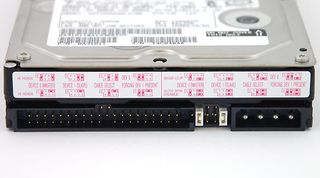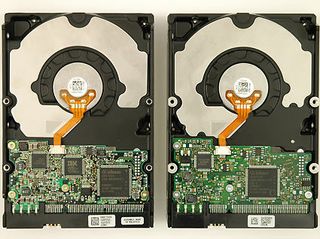T is for Turbo: The Hitachi DeskStar T7K250
The DeskStar T7K250 In Detail

The only way to tell Hitachi's hard drives apart is to look at the model information label on the top of the drive. In this respect, not much has changed since IBM sold its storage technology division to Hitachi, which became Hitachi Global Storage Technologies.
As mentioned above, the T7K250 employs a two-platter design, with each platter weighing in just shy of 130 GB. The older 7K250 still uses a three platter design with 85 GB each to reach its maximum capacity. As a side note, Hitachi's 400 GB monster, the 7K400, also uses this lower data density, employing a full five platters.
In addition to the advantage in data transfer rates as a result of increased density, the main benefit of using fewer platters lies in the much simpler design with fewer movable parts. Although the disk makers would never release failure statistics on their drives, it's a safe guess that simpler drives probably fail less frequently.
Following the "tried and tested" approach, Hitachi uses the UltraATA interface and equips the drive with 8 MB of cache. As a result, the DeskStar T7K250 is a good choice for systems not equipped with a SATA interface, making for an upgrade that offers both storage space and speed. Choosing the Serial ATA version will get you state-of-the-art drive logic complete with support for SATA II, 300 MB/s peak bandwidth and native command queuing.



Visually, it is impossible to tell the 7K250 and the T7K250 apart.
Stay On the Cutting Edge: Get the Tom's Hardware Newsletter
Join the experts who read Tom's Hardware for the inside track on enthusiast PC tech news — and have for over 25 years. We'll send breaking news and in-depth reviews of CPUs, GPUs, AI, maker hardware and more straight to your inbox.
Current page: The DeskStar T7K250 In Detail
Prev Page Upgrading: SATA Or UltraATA? Next Page Test SetupMost Popular



